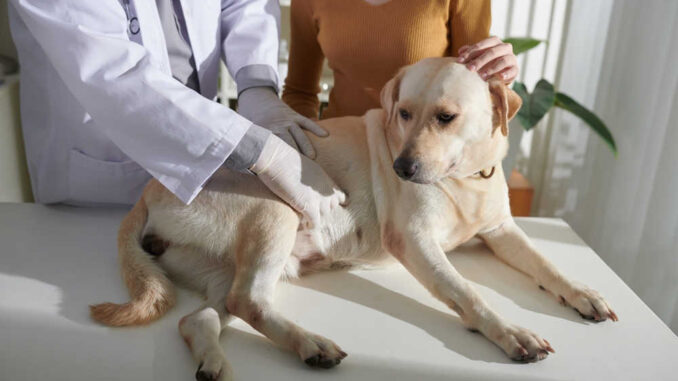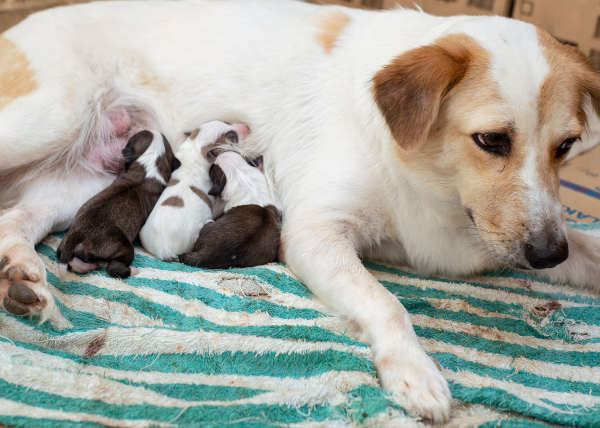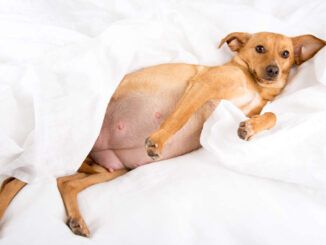
This article was updated on January 25th, 2024
There are certain times in a female’s dog life when brown discharge is considered normal, for example during the heat cycle or after giving birth. The rest of the time, brown discharge is cause for concern and should warrant a veterinary visit, especially in spayed dogs or dogs with other signs of illness. In this article, our veterinarian Dr. Chyrle Bonk explains when to be concerned, and what to do.
Key Takeaways:
– A normal brown discharge can be seen during the heat cycle & after giving birth.
– However, several health issues such as vaginitis or Urinary Tract Infections (UTIs) can also cause a brown discharge.
– It is uncommon for an abnormal discharge to be the only symptom. Keep an eye out for other signs of illness, such as lethargy, bad odor, or difficulty urinating.
– See your vet ASAP if you see other signs of illness or if the brown discharge is persistent or excessive
Normal brown discharge can be seen during the heat cycle & after giving birth
A difference between spayed and intact females, other than the ability to have puppies, is the amount of vaginal discharge that is normal. Intact females have a lot more instances of normal discharge than those that are spayed (due to heat cycles and giving birth). In some cases, a brown discharge from a female dog can be considered normal:
1. During the heat cycle: During a dog’s heat cycle, which occurs approximately every six to nine months, it’s common for there to be a scant discharge that transitions from red to pink or even brown as the cycle progresses.
A dog’s heat cycle lasts for 2-4 weeks, with discharge lasting 7-10 days. This discharge is a normal part of the reproductive cycle and will often be accompanied by increased urination, swelling of the vulva, aggressive behavior, and attracting male dogs. If you are unsure if your dog is in heat, read our article: Female Dogs In Heat: What They Look Like.
“Brown discharge during heat is considered normal as long as it doesn’t last for an extended period, doesn’t have a foul odor, and your dog is feeling normal”
See this picture from DogListener.co.uk showing a normal brown discharge.
2. After giving birth: another time when brown discharge in a dog is considered normal is after they have given birth or whelped. As the uterus clears out all of the fetal tissues and pregnancy fluids, a dog will normally have reddish-brown discharge for up to three weeks. As long as this discharge doesn’t have an odor and your dog is feeling alright, it is considered normal. Learn more about vaginal discharge in a pregnant dog.

Top causes of abnormal brown discharge in female dogs
If you see brown discharge outside of a dog’s heat cycle or if your dog is spayed, the discharge may be due to one of the following. Watch for any accompanying signs and contact your veterinarian.
1. Vaginitis: Inflammation of the vagina which can lead to irritation and mild bleeding, causing discharge to appear brown. Discharge will typically have a foul odor and may be brown, yellow, or red. Dogs may also urinate more frequently and lick or rub her genital area. Learn more about vaginitis.
2. Urinary tract infection: Infection in the urinary system can cause discolored discharge. UTIs often present with a small amount of blood that can look brown when diluted in other secretions. Dogs will also urinate more frequently or strain when urinating. Learn about UTIs in female dogs.
3. Pyometra: Serious infection of the uterus that may result in discharge presenting in an array of colors, including brown. Dogs may also run a fever, have a decreased appetite, lethargy and abdominal pain. This is an emergency, so see your vet immediately.
4. Hormonal imbalance: Disruption in hormone levels can lead to abnormal discharge.
5. Trauma or injury: Injury to the reproductive organs can cause red or brown discharge.
6. Tumors: Tumors or abnormal growths in the reproductive system can lead to discharge. Other signs would include noticeable lumps in the abdominal area, difficulty urinating or defecating, irregularities in the heat cycle, or other signs of illness such as lethargy or weight loss.
Other symptoms typically seen along with an abnormal brown discharge
“It is uncommon for abnormal discharge to be the only symptom that your dog is displaying. Keep an eye out for any other signs of discomfort or illness in your dog. This could provide you or your veterinarian with important clues to determine if your dog’s discharge is abnormal. If you have any doubts, discuss the situation with your vet.”
Along with the discharge look for any of the following signs:
- Frequent urination or difficulty urinating
- Lethargy or decreased energy
- Changes in appetite or thirst
- Abdominal pain or discomfort
- Swelling or redness in the genital area
- Foul odor accompanying the discharge
- Behavioral changes, such as excessive licking or restlessness
- Blood in the urine or stool
- Vomiting or diarrhea
- Weight loss or unexplained weight gain
When is it okay to wait-and-see?
For intact females, you may decide to monitor the situation if:
- the brown discharge is minimal,
- the brown discharge occurs during the normal heat cycle or following whelping, and
- your dog appears otherwise healthy.
When to see your vet
You should consult with your veterinarian any time you are concerned, and/or if:
- The brown discharge is persistent, excessive, or occurs outside of the normal heat cycle.
- Your dog exhibits any other concerning symptoms or behaviors (such as those listed above)
- The discharge is accompanied by an unusual odor or changes in appetite or energy levels.
- You have any doubts or concerns about your dog’s health.
- If your dog is spayed, brown discharge is more commonly a reason for concern
Is there anything I can try at home first before seeing the vet?
While it’s important to consult a veterinarian for a proper diagnosis, there are a few steps you can take at home to support your dog’s well-being as long as they are feeling otherwise normal:
- Keep the genital area clean by gently wiping with a warm, damp cloth (only do this as needed, in order to avoid causing unnecessary irritation that could worsen discomfort and discharge)
- Ensure your dog’s bedding is clean and comfortable; wash or replace any soiled bedding with fresh, clean, dry materials
- Avoid using any harsh chemicals or irritants in the vicinity of your dog’s genital area.
- Monitor your dog closely for changes in behavior, appetite, or other symptoms.
- Do not attempt to administer any over-the-counter medications without direct input from your dog’s veterinarian
Diagnosis and treatment
To determine the underlying cause of the brown discharge, your veterinarian will perform a thorough physical examination. From there, they may:
- collect a vaginal swab for microscopic analysis,
- conduct blood tests and a urinalysis, or
- perform imaging studies if necessary.
The treatment will depend on the specific diagnosis, and it may involve antibiotics, surgery, or other interventions as deemed appropriate by your veterinarian. It’s crucial to follow your vet’s instructions closely and attend any recommended follow-up appointments for the best possible outcome.
Related posts:
Disclaimer: This website's content is not a substitute for veterinary care. Always consult with your veterinarian for healthcare decisions. Read More.











Be the first to comment